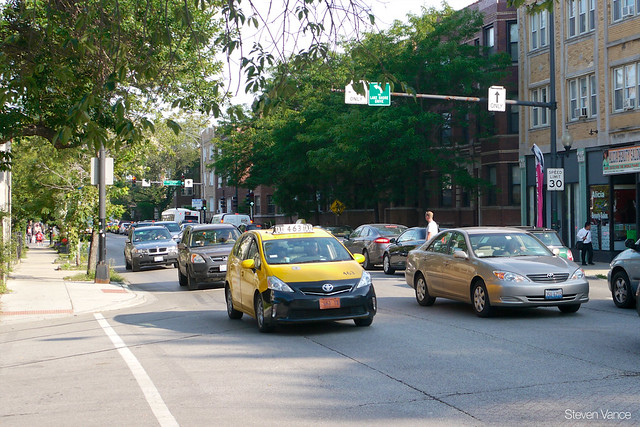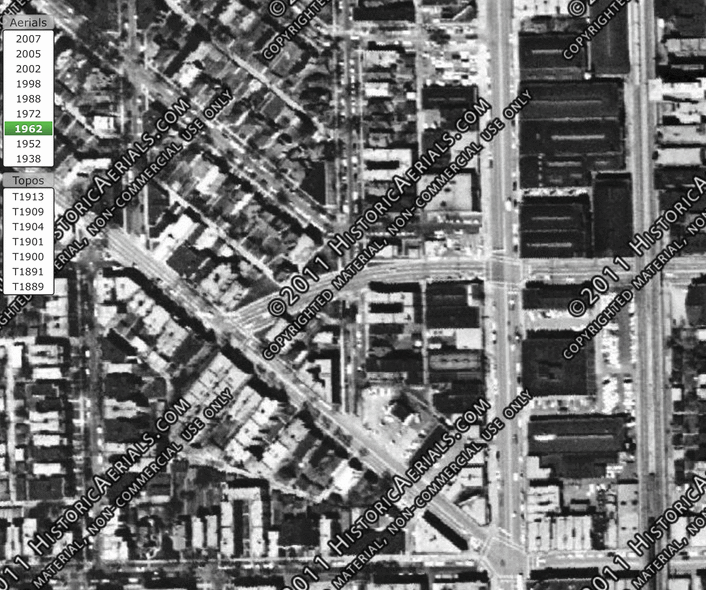The Edgewater neighborhood along the north lakefront should be a pleasant place to walk. It's the second-densest community area in the city, with 56,521 residents in an area just 1.5 miles across, and boasts lively commercial areas like Andersonville. Yet local residents say that their neighborhood is effectively cleaved into two by a roiling river of car traffic. The north end of Lake Shore Drive pumps tens of thousands of cars through the neighborhood, first onto Hollywood and then to Broadway or Ridge and onto Clark and Peterson.
To welcome this invading army of cars, over a dozen houses were leveled in the mid-1950s (animation below) to transform these local streets into four-lane traffic sewers -- roads meant to move many cars, quickly. This turned Hollywood and Ridge into impassable barriers, according to local residents like Claire Micklin. She says it's practically impossible to use marked crosswalks, because drivers simply refuse to stop. Even when traffic backups make it possible to get halfway across, fast-moving traffic thunders past in the other direction. Micklin says she dreads trying to cross, or even to walking alongside the streets -- since parking is banned, the never-ending traffic runs right next to the sidewalk:
Drivers drive as if they are on an extension of Lake Shore Drive, grinding to a halt at the lights that break up the thoroughfare. The cars just keep on coming, and even two of the four lanes are clear, there are usually cars speeding by on the other two lanes. I have seen people push baby carriages into the crosswalk, hoping that the other two lanes of traffic will stop. Even with a baby carriage in the middle of the road, people do not stop, and the person usually has to do a quick reverse back to where they started to cross.
Micklin lives just north of the tangled intersection where Hollywood, Ridge, Broadway, and Bryn Mawr all meet within one block of one another. The most convenient retail to her is clustered around the Bryn Mawr "L" stop, just south of Hollywood, or in Andersonville, a few blocks southwest, and none of the nearest crosswalks to her have traffic signals. Even where there are signals, as at Ridge and Hollywood, the streets are obviously engineered for cars: The signal timing favors the Ridge-Hollywood through traffic, and requires pedestrians to press a "beg button" that's inaccessible to children or people in wheelchairs. The intersection even features a highway-style, concrete Jersey barrier to keep skidding drivers from rolling right into someone's home.
Kevin Zolkiewicz lives a block south of the speedway. Like Micklin, he has to cross Hollywood or Ridge to get to services like the restaurants or the library on Broadway. He calls the walk "miserable... [I] have to go out of my way to cross at a light," Zolkiewicz said, adding that Ridge "acts as a barrier between Andersonville and the rest of Edgewater."
The never-ending stream of cars at Ridge and Hollywood.
Streetsblog contributor Justin Haugens and I observed traffic at two problematic intersections that Micklin identified -- Ridge/Wayne just west of the Ridge-Hollywood intersection, and Hollywood/Magnolia just to the east. These intersections are between traffic signals, so motorists are used to speeding up rather than stopping at these locations.
The two intersections both feature all four marked crosswalks, but the legs across the wider streets have faded nearly to black, neither have pedestrian refuge medians, and neither has a "stop for pedestrians" sign. (CDOT says that they will not install these on four-lane roads, due to the low probability that drivers in all four lanes will actually obey the sign.)
Micklin said that, due to the angled junction in between these two intersections, "there’s no visibility to see oncoming cars, and [thus] know that you can cross safely. I’ve been stuck in the middle of the road before, and people still don’t stop." We noticed half a dozen people during our study doing just that: Wiggling between stopped cars headed in one direction, then waiting in the middle of the road before running across the other lanes.
Using a radar gun, we found that the tight spacing of traffic signals largely prevented drivers from speeding during rush hour on Hollywood. The longer distances between signals on Ridge give more drivers a chance to gun it: 18 percent of drivers in the curbside lane exceeded the 30 mph speed limit during a 15 minute period on a weekday rush hour.
What makes Ridge and Hollywood impossible to cross is less the speed of the cars than their sheer numbers. An average of 33,100 cars every day (including weekends) pass the speed camera on Ridge, just south of Clark Street. That's as busy as the better-known crosstown traffic sewers of Western and Ashland avenues, each of which carry between 24,000 and 37,000 cars each day. Yet even those two streets can be easier to cross on foot, since they have parallel parking lanes and often feature medians.
In 2009, former 48th Ward Alderman Mary Ann Smith commissioned a livable streets study [PDF] from the Chicago Department of Transportation. Its "traffic gaps" analysis agrees with Micklin, saying it was "difficult to cross at unsignalized intersections for most of the day (9 a.m. to 10 p.m. on weekdays)." The study proposed a number of solutions: adding some car parking to Ridge (although not in the speed-plagued stretch), curb extensions on side streets to slow turns, redesigned bus stop areas, and new, usable beg buttons. Of the various fixes, only countdown signals have been implemented.
Zolkiewicz points out that when Alderman Harry Osterman, a life-long resident of the neighborhood, was elected to replace Smith, he promised to install a traffic signal at Ridge and Wayne.
Osterman's chief of staff Dan Luna confirmed this, saying it's under review by the Chicago Department of Transportation. Luna said "the bigger question is funding," since a new traffic signal would cost $300,000 to $350,000, and thus "would take a good quarter of our [annual] allocation" of ward-specific menu funds. Luna hadn't seen the livable streets study, but said he would "like to see one with newer data."
"It doesn’t make sense," Micklin said, "to have a speedway running through a residential area. Having a four-lane highway coming off of Lake Shore Drive — an actual highway/ speedway — just encourages drivers to speed, without consideration for pedestrians." She offered her own suggestions to make this area feel like a neighborhood again. Putting Ridge on a road diet, she said, and converting two of the four lanes to protected bike lanes "could force drivers to drive as if they are in a residential area, not a highway." The traffic could be redistributed onto other roads in the area, like Broadway and Foster.
As an interim step while neighbors wait for an updated traffic study, Micklin proposed to close off Ridge for a Sunday Parkways event. Such an event could "show how shutting down a superhighway can increase the feeling of community and the livability of a residential area."






